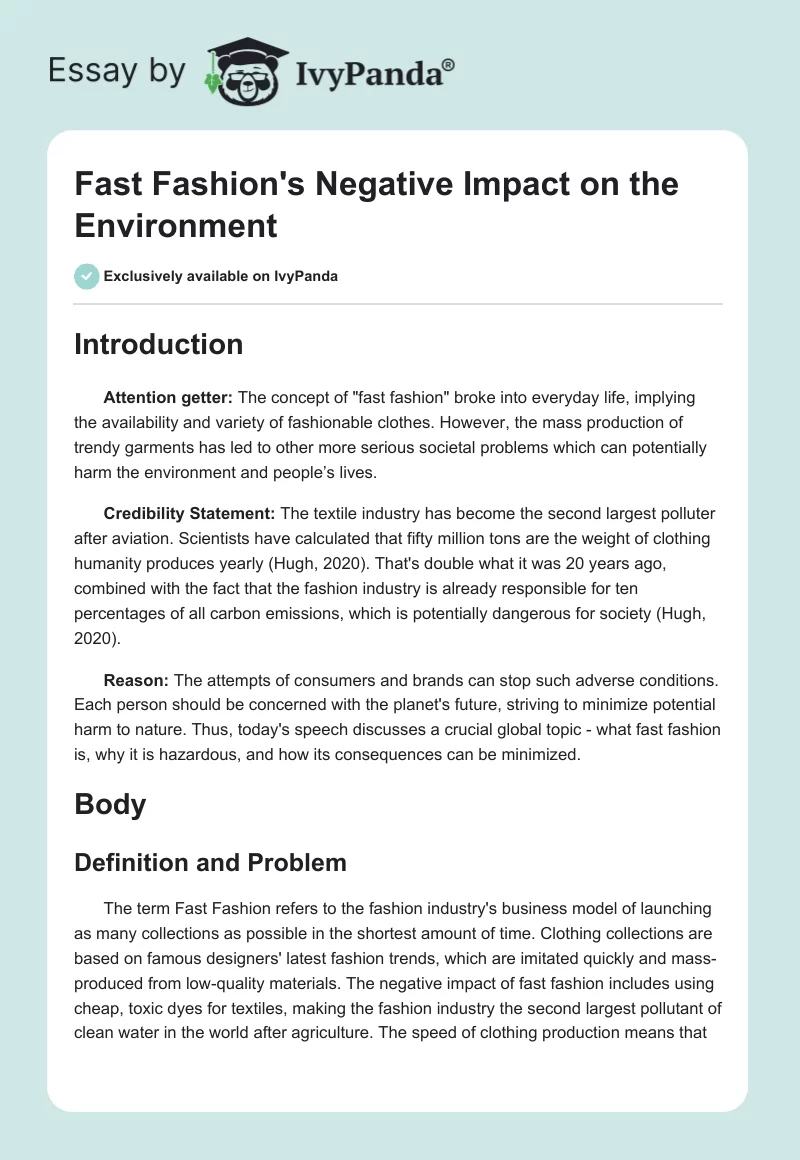Introduction
Attention getter: The concept of “fast fashion” broke into everyday life, implying the availability and variety of fashionable clothes. However, the mass production of trendy garments has led to other more serious societal problems which can potentially harm the environment and people’s lives.
Credibility Statement: The textile industry has become the second largest polluter after aviation. Scientists have calculated that fifty million tons are the weight of clothing humanity produces yearly (Hugh, 2020). That’s double what it was 20 years ago, combined with the fact that the fashion industry is already responsible for ten percentages of all carbon emissions, which is potentially dangerous for society (Hugh, 2020).
Reason: The attempts of consumers and brands can stop such adverse conditions. Each person should be concerned with the planet’s future, striving to minimize potential harm to nature. Thus, today’s speech discusses a crucial global topic – what fast fashion is, why it is hazardous, and how its consequences can be minimized.
Body
Definition and Problem
The term Fast Fashion refers to the fashion industry’s business model of launching as many collections as possible in the shortest amount of time. Clothing collections are based on famous designers’ latest fashion trends, which are imitated quickly and mass-produced from low-quality materials. The negative impact of fast fashion includes using cheap, toxic dyes for textiles, making the fashion industry the second largest pollutant of clean water in the world after agriculture. The speed of clothing production means that consumers are throwing away more and more clothing, creating vast amounts of textile waste.
Causes
The low-cost characteristic of the mass market is achieved, among other things, by reducing the cost of creating clothes. And this is the constant increase in production capacity, the low quality of the product, and the use of the labor of the population of developing countries. The result of this approach has been legitimate criticism of fast fashion for pollution. Short-term trends, low-quality garments, and a focus on synthetics lead to increased emissions during production.
In a fast fashion, artificial fibers are often used, such as polyester. Such materials are harmful to the environment, as they are made from crude oil, and carbon dioxide is released during production. Chemicals also pollute the waters in the seas and rivers. When washing clothes in a washing machine, tiny fibers end up in the ocean in the form of microplastic particles. But even “natural fabrics” can become a problem on the scale of fast fashion. Growing cotton requires vast amounts of water and pesticides. This leads to the risk of drought, creates pressure on water basins, as well competition for resources between companies and local communities.
Solutions
There can be two solutions directed to fashion brands and consumers. Fast fashion brands have expressed concern that they are damaging the environment. As such, these brands are taking initiatives to create more sustainable clothing and sustainable brands. For example, UNIQLO (Japan) has developed a technology to reduce the use of used clothing. He also recycles them into the new fabric to make new clothes. This recycling method should be an example for other brands. All parties in the supply chain must work to preserve the environment during production. The goal is to avoid polluting the environment with textile waste.
Brands work based on the constant production of new clothing lines to meet the ever-changing consumer demand for everything new. Therefore, the buyer can take some steps to reduce the demand for quick-change products. For example, you and I can check the composition and wear clothes made from natural materials and renewable resources. If the clothes are in good condition, you can give them away or even sell them, thereby delaying the moment things enter the landfill, simultaneously satisfying the other person’s need for clothes. Wear the clothes you love. Do not accept or return clothing that is in doubt. One of the most valuable pieces of advice can be to avoid following fleeting trends but choose your style. It can help to feel more comfortable wearing all of the clothes. It is essential to save time in searching. Try to select a high-quality, comfortable and suitable thing for you in all respects. Customers can give preference to products made by responsible companies. Responsible companies strive to reduce their environmental impact by using renewable energy and recycled materials, avoiding the animal cruelty, and respecting workers’ rights at all stages of production.
Conclusion
Therefore, fast fashion is one of the most potentially dangerous widely-spreading production spheres, which has significant adverse environmental consequences. The possible solutions include recommendations for becoming more attentive consumers. The fashion brand also can take some measures, such as improving the quality of materials. Consumers’ and production companies’ complex attempts consumers and production companies’ problematic attempts can help fast fashion become slower.
In conclusion, we are all, as consumers, responsible for drafting the demand for clothes. Rational consumption can change the supply of fast fashion trends. Even small attempts can provoke more significant changes in the global situation. Our current culture of applying things is unsustainable. But by knowing who a conscious consumer is and how to refuse the number of utilized clothes, we can improve the condition of the environment and minimize the consequences of fast fashion.
Reference
Hugh. (2020). Environmental impact of fast fashion. GetGreenNow. Web.


